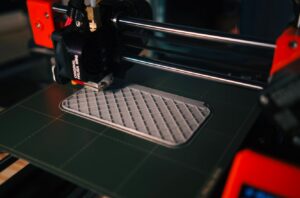How to confirm whether the shape and position tolerances are up to standard after the parts are manufactured? What testing methods are there? Today we will take you to understand some common detection content and detection methods.
Test method for straightness
- Place the ruler parallel to the measuring surface, and use a feeler gauge to measure the gap between the ruler and the object to be measured.
(1) When measuring surface concavity, a feeler gauge with a thickness equal to the straightness cannot be inserted into the central gap.
(2) When measuring surface convexity, place a feeler gauge with a numerical thickness equal to the straightness at both ends.
- Put the lever dial indicator on the measurement surface, adjust to zero at point A, and confirm to point B. Measured value = maximum value – minimum value
Flatness test method
- Measure the flatness of parts with a ruler
Measurement method: Support the measurement object by the method not including its own weight.
Measuring range: The measurement is to place a ruler on the entire surface (vertical, horizontal, and diagonal directions) and use a feeler gauge (the value is consistent with the flatness) to measure.
Judgment: The feeler gauge should not pass in all places.
- Use a platform to measure flatness
Measurement method: place the part flat on the platform, and use a feeler gauge to measure the gap between the part and the platform.
The feeler gauge and the platform should be kept horizontal for measurement.
- Measure the flatness with dial indicator
Put the lever indicator on the measurement surface, adjust to zero at point A, and confirm to point B.
Measured value = maximum value – minimum value
Parallelism test method
- Parallelism between surfaces
Use a V-shaped block on the platform to maintain the reference plane, measure the entire surface of the measuring surface with a lever dial indicator, adjust to zero at point A, and confirm point B.
Measure on the face of the required measurement.
Measured value = maximum value – minimum value
- Parallelism between lines and surfaces
(1) Insert the appropriate plug gauges into the two reference holes.
(2) Support both ends of the plug gauge with parallel blocks (or magnets).
(3) Adjust the specified plane of the tolerance to be parallel to the platform, adjust to zero at point A, and confirm to point B.
(4) Measure the specified surface, and use the maximum difference of the readings (the highest point minus the lowest point) as the parallelism.
- Parallelism between surface and line
On the platform, use magnets to support the whole datum plane, measure the dimensions from the two holes to the datum plane, and use the difference of the dimensions as the parallelism.
(1) Insert suitable plug gauges into the two reference holes.
(2) Fix both ends of the plug gauge with parallel blocks (or magnets).
(3) Calculate the center offset (X) of EB and EC at the position of 0°, and calculate the center offset (Y) of EB and EC at the 90° rotation position.
(4) Calculate the obtained value with the root sign (X2 +Y2), and the obtained value is the parallelism.
Test method for verticality
- Perpendicularity between surfaces
(1) Support the datum plane parallel to the platform with magnets.
(2) Move the dial indicator from the root of the bend to the front end, and take the maximum difference of the readings as the verticality.
Note: The measurement is across all places of l.
- Perpendicularity between surface and line
(1) On the platform, use a magnet to support the measurement object;
(2) Touch the dial indicator to the measuring object, adjust to zero at point B, and confirm to point C.
(3) Touch the dial gauge to the measuring object, and move it up and down in all places within the indicated range.
(4) The measurement is carried out at two positions of 0° and 90°.
(5) Calculate the maximum difference of each reading with the following formula, and the obtained value is the perpendicularity (the maximum difference of the reading at 0°→X; the maximum difference of the reading at 90°→Y):
Perpendicularity (E) = square root ( X2 +Y2 )
- Perpendicularity between lines and surfaces
(1) Insert suitable plug gauges into the two reference holes; use magnets on the platform to support the plug gauges at right angles to the platform.
(2) Measure all places on the measuring surface with a dial gauge (or height gauge), and use the maximum difference of readings as verticality.
Test method for concentricity
- Two benchmark types of coaxiality
(1) Specify the benchmark
Based on the axis line of a cylindrical surface given on the part, that is, the value of pA to B and pB to A.
(2) The public axis line as the reference
Assuming that there are two holes A and B on the part, when measuring the coaxiality error, neither hole A nor hole B shall be used as the reference, but the common axis line of the two holes A and B shall be used as the reference. The coaxiality errors of the two holes A and B to the common axis are pB and pA respectively.
- Measurement of coaxiality
(1) Measurement of the coaxiality error of the specified datum
Measure the concentricity of hole B to hole A with the axis of hole A as the reference.
Measurements must be taken both horizontally and vertically.
(2) Measurement of the coaxiality error based on the common axis line
When measuring, first fix the measured part on the platform, and measure the full length of the measured axis of the two holes A and B respectively. The maximum reading difference between the measured axis line and the common axis line is the coaxiality error.
How to check the inclination
Put the reference surface of the part on the platform, and use the dial gauge to move the measured surface. When the difference between the maximum and minimum readings indicated on the dial gauge is the smallest, the difference is the inclination error.
Hope the above content can help you!




